Types of hijab
This table of types of hijab describes terminologically distinguished styles of Islamic clothing commonly associated with the word hijab.
 |
| Part of a series on |
| Islamic female dress |
|---|
| Types |
| Practice and law by country |
| Concepts |
| Other |
The Arabic word hijāb can be translated as "cover, wrap, curtain, veil, screen, partition", among other meanings.[1] In the Quran it refers to notions of separation, protection and covering in both literal and metaphorical senses.[2] Subsequently, the word has evolved in meaning and now usually denotes a Muslim woman's veil or the notion of separation between the sexes.[2] In English, the term refers predominantly to the Islamic head covering for women and its underlying religious precepts.[3][4]
| Name | Image | Description |
|---|---|---|
| Abaya عباية | 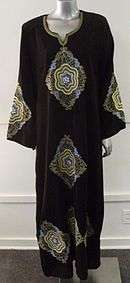 |
Full-length, robe-like outer garment that covers the whole body except the head, feet, and hands. Usually worn with a headscarf or (especially in Saudi Arabia) gloves and niqab. |
| al-Amira | 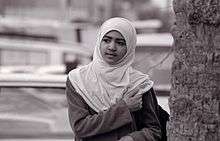 |
A two-piece veil. It consists of a close fitting cap, usually made from cotton or polyester, and an accompanying tube-like scarf. |
| Bushiyya |  |
A veil that is tied on at the forehead and falls to cover the entire face but has no cut-out for the eyes; instead, the fabric is sheer enough to be seen through (Middle East, specifically Persian Gulf). |
| Bukhnuq بخنق | 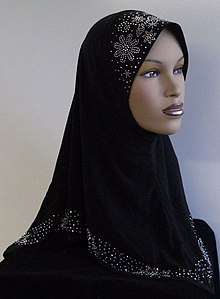 |
This is similar to khimār 2 (see below) but comes down just to the bosom. Sometimes called "Amira hijab" if it has embroidery at the edge. |
| Eastern Arabia Batula برقع شرق الجزيرة العربية | 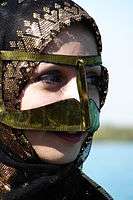 |
Women wear it in United Arab Emirates, Oman, Qatar and Arabs of Southern Iran. This tradition has almost died out in the newer generations. Older women past 50, and those living in rural areas can still be seen wearing them. |
| Burqa or Chadari برقع، چادری | 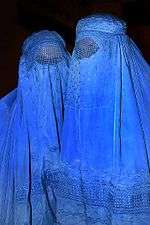 |
Traditional Central Asian[5] style outer garment that covers the entire body and has a grille over the face that the woman looks through. Very similar in style and function to other Central Asian styles such as the paranja. |
| Chador | 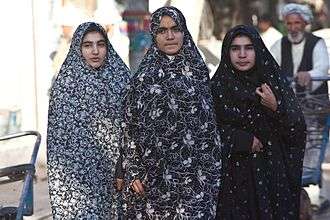 |
An Iranian traditional outer garment (also worn in other countries) that covers the head and body and is a full-length semicircle of fabric but comes down to the ground. Does not have slits for the hands and is held shut with the hands, teeth or simply wrapped under the arms. |
| Elechek |  |
White turban traditionally worn by Kyrgyz women, currently reserved for special occasions.[6][7] |
| Hijāb حجاب |  |
May refer to any head covering. See Hijab |
| Jilbāb (1) جلباب | generic | The term used in the Qur'an (Suratu l-Ahzāb, āya 59) to refer to the outer garment. In Indonesia, the term jilbab refers exclusively to the head-covering. |
| Jilbāb (2) |  |
A type of outer garment that looks like a long raincoat or trenchcoat. |
| Kalpak | 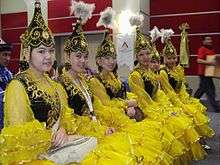 |
Traditional headgear of unmarried woman in Kazakhstan, Karakalpakstan and Kyrgyzstan. |
| Kerudung |  |
Although similar to the Malaysian tudong (below), the modern Indonesian kerudung usually includes a stiff visor above the eyes. |
| Khimār (1) خمار | generic | The term used in the Qur'an (Suratu n-Nūr, āya 31) to refer to the headscarf; the word "hijāb" is more commonly used with this meaning. |
| Khimār (2) |  |
Most commonly, a circular head covering with a hole cut out for the face, which usually comes down to the waist. Note the variations bukhnuq and chador above, which are the same style but different lengths. |
| Kimeshek (kk:Кимешек) | 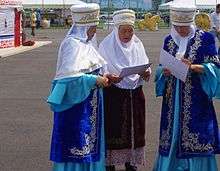 |
Traditional headgear of married woman in Kazakhstan, Karakalpakstan and Kyrgyzstan. |
| Kurhars (ru:Курхарс) | 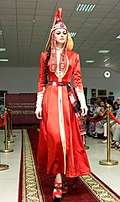 |
Traditional headgear of unmarried woman in Ingushetia. |
| Mukena | 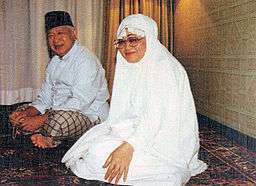 |
An Indonesian hijab worn almost exclusively for praying. It is fastened around the head with two strings. Colours are usually white or pastel. |
| Niqaab نقاب | 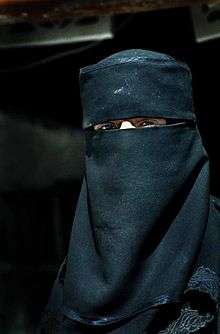 |
A veil that covers the face and entire head but with a place cut out for the eyes (image: style worn in Yemen). |
| Niqaab (2) | 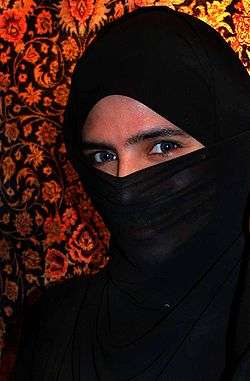 |
A veil that is tied on at the bridge of the nose and falls to cover the lower face. Also called "half niqab". |
| Oramal (kk:Орамал) | A traditional kerchief used in Central Asia and the Caucasus (note how it is banded, the neck is usually not covered by it). In some countries like Uzbekistan it was traditionally used only at home, while in public the paranja was more popular. In other countries, like Kazakhstan, it was commonly used in public. In Kyrgyzstan, the white color is an indication that the woman is married. | |
| Paranja | 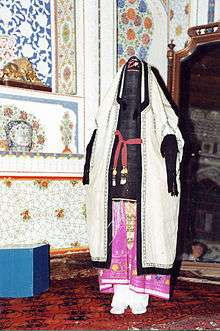 |
A Central Asian traditional outer garment that covers the head and body, heavy in weight and made from horsehair. Once prevalent in Uzbek and Tajik societies. |
| Selendang | .png) |
In Southeast Asia, a multi-purpose shoulder sash that can be tied around the shoulders to carry infants and groceries, or draped over the head. |
| Shayla |  |
Long, rectangular scarf, wrapped around the head and tucked or pinned in place at the shoulders. Popular in Arab states of the Persian Gulf.[8] |
| Taqiyah (cap) | .jpg) |
|
| Tudung or Kerudung | .jpg) |
Headscarf worn in Malaysia and Indonesia. In Indonesia, the term kerudung is much more common. |
| Türban |  |
Turkish term for a headscarf pinned neatly at the sides.[9] |
See also
- Islam and clothing
References
- El Guindi, Fadwa; Sherifa Zahur (2009). Hijab. The Oxford Encyclopedia of the Islamic World. doi:10.1093/acref/9780195305135.001.0001. ISBN 9780195305135.
- Siddiqui, Mona (2006). "Veil". In Jane Dammen McAuliffe (ed.). Encyclopaedia of the Qurʾān. Brill.
- Hijab in Merriam-Webster
- Hijab at Oxford Dictionaries
- Abu-Lughod, Lila (2002). "Do Muslim Women Really Need Saving? Anthropological Reflections on Cultural Relativism and Its Others". American Anthropologist. 104 (3): 783–790. doi:10.1525/aa.2002.104.3.783.
- BBC Trending (13 August 2016). "Kyrgyzstan president: 'Women in mini skirts don't become suicide bombers'". BBC.
- Bradley Mayhew, Greg Bloom, Paul Clammer, Michael Kohn (2010). Central Asia. Lonely Planet. p. 63. ISBN 9781741791488.CS1 maint: uses authors parameter (link)
- BBC, In graphics: Muslim veils
- Rainsford, Sarah (November 7, 2006). "Headscarf issue challenges Turkey". BBC News.
External links
This article is issued from Wikipedia. The text is licensed under Creative Commons - Attribution - Sharealike. Additional terms may apply for the media files.